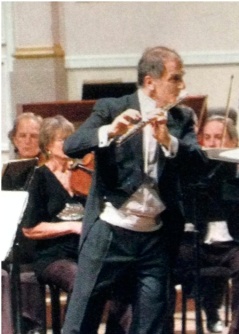For many years when I thought about playing flute I couldn’t even imagine free movement. Even my visualized performances were dystonic and distorted. The left side was dominant in my imagination. It was awkward and tight compared to the right.
This picture of Argentinian flutist Claudio Barile from Flute Talk magazine helped me think through my own whole body movement while playing, and practice more efficient proprioceptive visualization.

I began to reimagine and retrain my own visualized movement as how I imagine Claudio’s to be according to this photo. I put this photo on my stand every time I play and have a clear mental image of it. His “up and over” from the back of the head, fluid energy, whole body in motion (not fingers in motion), equality of left and right sides, and use of the floor as “support” was so helpful as I reimagined my own relationship to the instrument. This deliberate and targeted visualization translated into a new quality of whole body movement, which in turn released some of the dystonic movement in the left hand. My actual movement responded to the process of visualizing fluid movement.
In her book The Art of Grace, Sarah L. Kaufman, the dance critic for the Washington Post, describes this distinction between what for me has been the difference between considering the quality of whole body movement as opposed to the narrow focus on my left hand.
“Thinking about the quality of movement – how you want your way of walking to look and feel, as opposed to focusing on the mechanics of taking steps – is what dancers work on a lot. It’s an aesthetic goal rather than a functional goal.” Sarah L. Kaufman The Art of Grace
For me, visualizing a new aesthetic has allowed for improved function.

I loved all of these. Bravo!!! You have much to offer the world through sharing your process. Thank you!
LikeLike